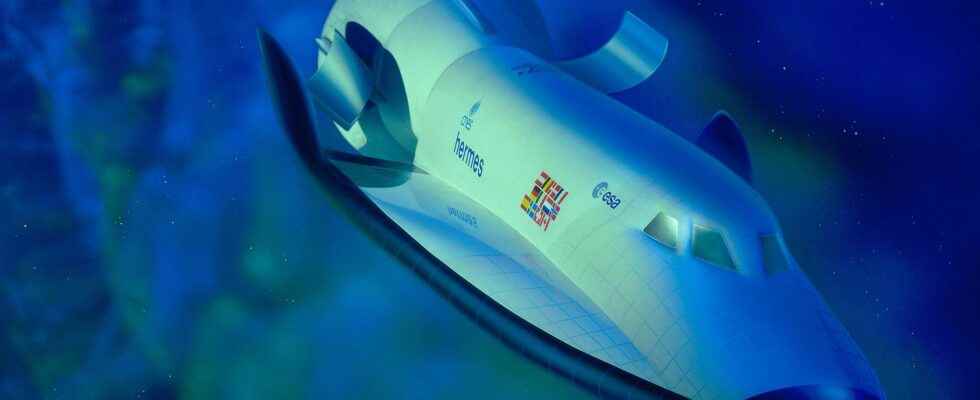Hermès is the name of the program, now abandoned, of a small space shuttle. Small in contrast to the size of the american space shuttle, much larger. Initially, Hermès was designed to serve a small station in orbit low and bring materials made in orbit back to Earth. Designed to fly up to about 400 kilometers altitude where, at the time, a station was envisaged orbitalHermès was to embark a crew of four to six astronauts (or a reduced crew) but with greater cargo carrying capacity. At the time of its abandonment, a first flight was expected in the late 2000s.
This project was part of a “manned flight” program also providing for the Columbus program which included:
- the Columbus APM pressurized laboratory (Attached Pressurized Module) attached to Freedom;
- the columbus Man Tend Free Flyer (MTFF);
- the European polar platform PPF (Polar Platform).
Initially supported by France at the end of the 1970s, this program was then “Europeanized” before being definitively abandoned in November 1992. When it was abandoned, the specifications provided for a vehicle 18.6 m long, of which 12, 7 for the aircraft and 5.9 for the MRH resource module, and a launch mass of 22 tons with a carrying capacity of 3 tons. The cockpit had to be able to carry a crew of three astronauts. She offered a volume 14.4m3 and, unlike the space shuttle of the Nasa, the cabin gave direct access to the pressurized hold which communicates directly with the MRH service module via a corridor. The module, 25.4 m3grouped the reservoirs ofpropellantspart of the payload and the spacesuits for the EVAs.
The Hermès shuttle was designed for three types of missions:
- Scientific, with autonomous missions for theearth observationcarrying out scientific experiments and technology demonstrations, for example.
- From service to satellites with appointments in orbit to refuel, troubleshoot or repair satellites.
- Round-trip flights to an orbital station for crew rotation and cargo transportation. At the time, the international space station did not exist in its current form. It was about the Freedom station and the Columbus module.
Hermès much more reliable than the American shuttle
The fundamental difference between Hermès and the space shuttle was its integration with its launcher. I’space plane European was located above the Ariane 5 launcher and not against, as was the case for the shuttle. In terms of safety, Hermès aimed for more than 99.999% (the reliability of the launcher Ariadne 5 being 99%), the 0.001 being covered with a crew ejection system, which thechallenger crew who died not in the shuttle explosion but when it crashed into the ocean.
The abandonment of the Hermès program cannot be explained solely by a lack of political will. From a technical point of view, the concept was also very ambitious and proved to be technically and financially unfeasible under the conditions originally envisaged. What Hermès also lacked is that, unlike the Ariane program which won unanimous support because it was to give Europe independent access to space, this project was not as unifying as Ariane . Some countries were not convinced of the usefulness of a spaceplane. For Italy and Germany, Hermès and the manned flights were not justified. The program was seen as a technological project without great operational value, like the Concorde.
You will also be interested
[EN VIDÉO] The astronomical and space events not to miss in 2022 The year 2022 will be marked by major space and astronomical events almost every month, a small recap of the most important is always welcome!
Interested in what you just read?
